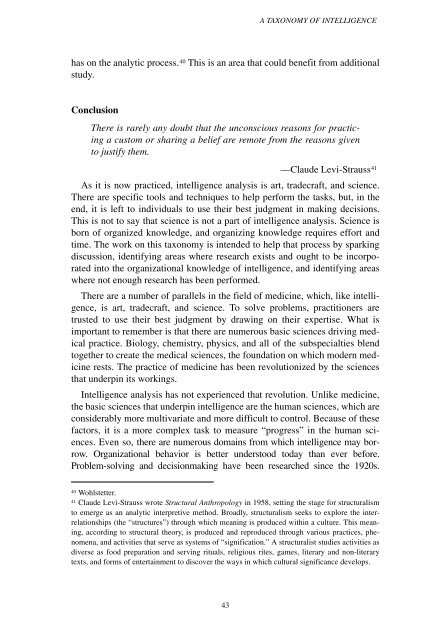Analytic Culture in the U.S. Intelligence Community (PDF) - CIA
Analytic Culture in the U.S. Intelligence Community (PDF) - CIA
Analytic Culture in the U.S. Intelligence Community (PDF) - CIA
You also want an ePaper? Increase the reach of your titles
YUMPU automatically turns print PDFs into web optimized ePapers that Google loves.
A TAXONOMY OF INTELLIGENCE<br />
has on <strong>the</strong> analytic process. 40 This is an area that could benefit from additional<br />
study.<br />
Conclusion<br />
There is rarely any doubt that <strong>the</strong> unconscious reasons for practic<strong>in</strong>g<br />
a custom or shar<strong>in</strong>g a belief are remote from <strong>the</strong> reasons given<br />
to justify <strong>the</strong>m.<br />
—Claude Levi-Strauss 41<br />
As it is now practiced, <strong>in</strong>telligence analysis is art, tradecraft, and science.<br />
There are specific tools and techniques to help perform <strong>the</strong> tasks, but, <strong>in</strong> <strong>the</strong><br />
end, it is left to <strong>in</strong>dividuals to use <strong>the</strong>ir best judgment <strong>in</strong> mak<strong>in</strong>g decisions.<br />
This is not to say that science is not a part of <strong>in</strong>telligence analysis. Science is<br />
born of organized knowledge, and organiz<strong>in</strong>g knowledge requires effort and<br />
time. The work on this taxonomy is <strong>in</strong>tended to help that process by spark<strong>in</strong>g<br />
discussion, identify<strong>in</strong>g areas where research exists and ought to be <strong>in</strong>corporated<br />
<strong>in</strong>to <strong>the</strong> organizational knowledge of <strong>in</strong>telligence, and identify<strong>in</strong>g areas<br />
where not enough research has been performed.<br />
There are a number of parallels <strong>in</strong> <strong>the</strong> field of medic<strong>in</strong>e, which, like <strong>in</strong>telligence,<br />
is art, tradecraft, and science. To solve problems, practitioners are<br />
trusted to use <strong>the</strong>ir best judgment by draw<strong>in</strong>g on <strong>the</strong>ir expertise. What is<br />
important to remember is that <strong>the</strong>re are numerous basic sciences driv<strong>in</strong>g medical<br />
practice. Biology, chemistry, physics, and all of <strong>the</strong> subspecialties blend<br />
toge<strong>the</strong>r to create <strong>the</strong> medical sciences, <strong>the</strong> foundation on which modern medic<strong>in</strong>e<br />
rests. The practice of medic<strong>in</strong>e has been revolutionized by <strong>the</strong> sciences<br />
that underp<strong>in</strong> its work<strong>in</strong>gs.<br />
<strong>Intelligence</strong> analysis has not experienced that revolution. Unlike medic<strong>in</strong>e,<br />
<strong>the</strong> basic sciences that underp<strong>in</strong> <strong>in</strong>telligence are <strong>the</strong> human sciences, which are<br />
considerably more multivariate and more difficult to control. Because of <strong>the</strong>se<br />
factors, it is a more complex task to measure “progress” <strong>in</strong> <strong>the</strong> human sciences.<br />
Even so, <strong>the</strong>re are numerous doma<strong>in</strong>s from which <strong>in</strong>telligence may borrow.<br />
Organizational behavior is better understood today than ever before.<br />
Problem-solv<strong>in</strong>g and decisionmak<strong>in</strong>g have been researched s<strong>in</strong>ce <strong>the</strong> 1920s.<br />
40<br />
Wohlstetter.<br />
41<br />
Claude Levi-Strauss wrote Structural Anthropology <strong>in</strong> 1958, sett<strong>in</strong>g <strong>the</strong> stage for structuralism<br />
to emerge as an analytic <strong>in</strong>terpretive method. Broadly, structuralism seeks to explore <strong>the</strong> <strong>in</strong>terrelationships<br />
(<strong>the</strong> “structures”) through which mean<strong>in</strong>g is produced with<strong>in</strong> a culture. This mean<strong>in</strong>g,<br />
accord<strong>in</strong>g to structural <strong>the</strong>ory, is produced and reproduced through various practices, phenomena,<br />
and activities that serve as systems of “signification.” A structuralist studies activities as<br />
diverse as food preparation and serv<strong>in</strong>g rituals, religious rites, games, literary and non-literary<br />
texts, and forms of enterta<strong>in</strong>ment to discover <strong>the</strong> ways <strong>in</strong> which cultural significance develops.<br />
43
















